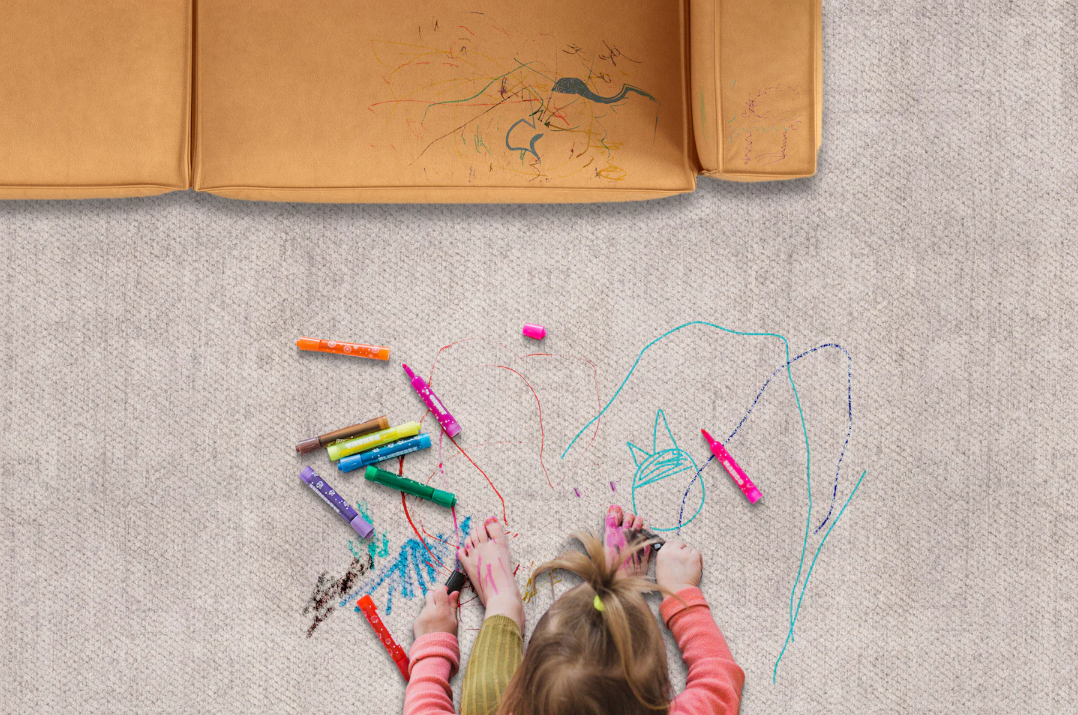
This article is more than
2 year old
Should parents put off creating the home of their dreams, knowing that a toddler will draw on all of it?
I was standing in the kitchen, unloading the dishwasher, when I heard the cheerful voice of my 22-month-old from the living room. “Dark blue,” he sang, “Dark, dark blue!”
So cute, I thought, stacking plates. I wonder what he’s singing about. Then, with sudden certainty, I knew. The rug. Oh God, the rug.
Here I must back up and explain that the rug — thick, cream-colored wool, neither cheap nor machine washable, but so lovely — was doomed from the start. We had acquired it as excited first-time homeowners four years earlier, when we had an infant daughter and an old dog, both of whom spent much of their waking hours regurgitating fluids. In the years since, as we added another child to the mix, we’d grown ever more adept at dabbing and spot-cleaning and vacuuming and cringing. The rug took a beating, but it was hanging in there.Until that evening in July 2022, when I bolted from the kitchen to the living room and found my toddler artiste, a marker in his fist as he rolled joyfully atop a rug that was now emphatically marked with bold (dark blue) lines, and I knew then that the rug wasn’t coming back from this one.
I wondered if this was a lesson, a reminder that kids and nice things don’t really mix, that the joy of a pleasing aesthetic can’t trump the unbridled chaos and mess of small children. What’s the right call? Do you create a home you love knowing that a baby might gnaw on your wood furniture like a tiny beaver, or leave colored pencil scratches on the dining room table, or add Crayola stripes to the area rug? Do you put off owning something you’d enjoy, keep a beloved heirloom locked away until some later, safer date? I decided to ask a couple of interior designers who are also parents and spend much of their time designing spaces for families.
“Parents are wondering this all the time,” Saudah Saleem, an interior designer and mother of five in Maryland, told me. “So many are like, ‘I love this aesthetic, but is it realistic to move forward with this?’ ”
These might be parents who are looking to transform their home, or maybe they just want to live comfortably, or perhaps they have their eye on a single room or piece of nice furniture. “But they also have children, who are not going anywhere for 18 years at least. And no, you don’t wait 18 years to be comfortable at home!” Saleem says. “I truly don’t believe it’s a sacrifice you have to make.”
Okay! So maybe the rug wasn’t such a ridiculous choice after all?
“Well…” says Lina Galvão, co-founder of the design studio Curated Nest and a mom of two in Connecticut, and I can tell she’s trying to think of the gentlest way to say this. “Rugs and accessories — those are the things you’re going to invest the least in, at least if you have kids or pets ... I don’t usually recommend an expensive rug.” She pauses, then adds, very kindly: “Or, maybe a darker color?”
But with other key items (couches, tables, cabinets, shelving) Galvão does suggest investing in something that will last, if possible. “Your entire home is going to age and wear more beautifully if you make good selections to start with,” she says. “Wear and tear is inevitable, and we try to pick furnishings and materials that are going to resist that as much as possible, but nothing is 100 percent bulletproof. And you never know what your kids are going to bring to the table.”
(I confess that my son once literally brought his brand-new baby teeth to the corner of our solid cherry coffee table, but Galvão is unfazed. “Oh, that’s patina,” she says, laughing. “That’s fine!”)
Whatever our goal or budget, whatever our personal style, both Galvão and Saleem emphasize that the decisions we make about our home matter more than we might realize.
Before she became an interior designer, Galvão worked in health care, she says; she spent a lot of time in hospitals, where she noticed how profoundly the physical environment affected the emotional state of the patients who were there to receive care.
That connection is especially true in our own homes, too, she says. “I think a lot of people will kind of dumb down or minimize the impact of having a well-designed space, and what that does for your well-being and mental health,” she says. “Our homes are one of the few spaces in our lives where we have full creative control. It is a blessing to have a home that feels like you.”
Saleem agrees that aesthetics play a role in how we feel — the colors that we use, the mood it evokes. “And that trickles down,” she says. “How does our mood impact our kids’ moods?”
Here, then, is where we have to know a little something about our moods, and what evokes them. If a lighter-colored couch makes you happy, that matters; if a child spilling juice all over it will send you into the stratosphere, that matters, too. (Fortunately, the designers note, there are far more stain-resistant materials out there these days, which make a wider range of colors feasible.) We should consider how we feel about delaying something that makes us happy, the right balance between embracing the present while planning for the future.
This question also arises often around furniture that has been passed down in families, over which we might feel especially protective. I tell Galvão about the dining room furniture in my house, a solid walnut table and cabinet of Scandinavian design that belonged to my grandparents throughout my own childhood. Before the table stood in our house, it was waiting for us in a storage unit — and we could have left it there longer, where it wouldn’t be scarred by pencils and Hot Wheels.
“But why shouldn’t you be surrounded by beautiful things every day that mean a lot to you?” Galvão says. “It’s beautiful, it’s meaningful, it’s free. Use your heirlooms!” But: “Know thyself,” she adds, repeating the phrase for emphasis. If your jaw is clenched every time a child is in proximity to your cherished hand-me-down, perhaps employ a protective barrier, or place it somewhere less trafficked.
Saleem is also in favor of including our most beloved pieces — “heart pieces,” she calls them — in our spaces. And if we’re going to be living around them, then life is going to happen to them. “But if it’s locked away in a storage unit until your kids are 25, you’re missing all those moments, that part of the story,” she says. Consider the coffee table chomped by a teething baby: “It’s not funny now, but maybe in 10 years, he’ll say, ‘That’s my teeth mark!’” she says. “Not every piece in your house needs to have that kind of story — but I do find that is how we infuse our own touches in a space, our personality, our family’s personality, our culture.”
Two professional cleanings later, in dim-enough lighting, the wool rug still looks decent enough; next time, we’ll choose a washable one. I no longer levitate from my chair when my kids rake utensils against the dining room table. In another decade or two, we could refinish all the solid wood surfaces in our house — wipe clean all evidence of this messy era of life, the etchings of my daughter’s drawings, the teeth marks on the coffee table. I have a feeling we won’t want to.